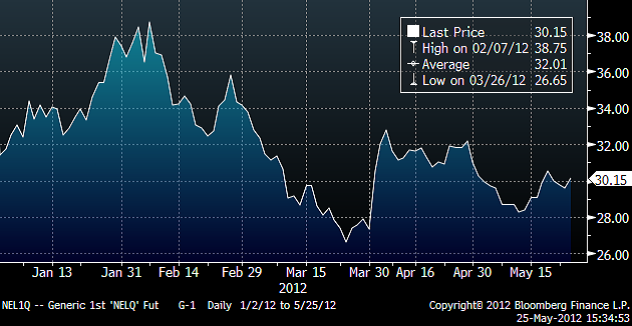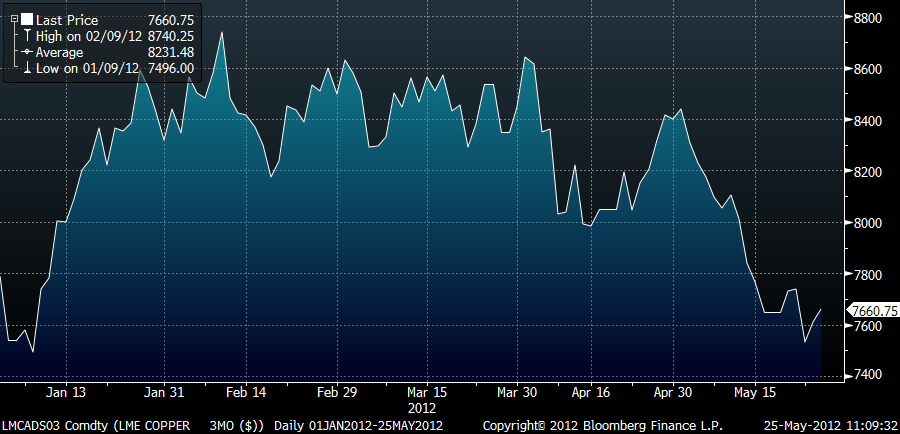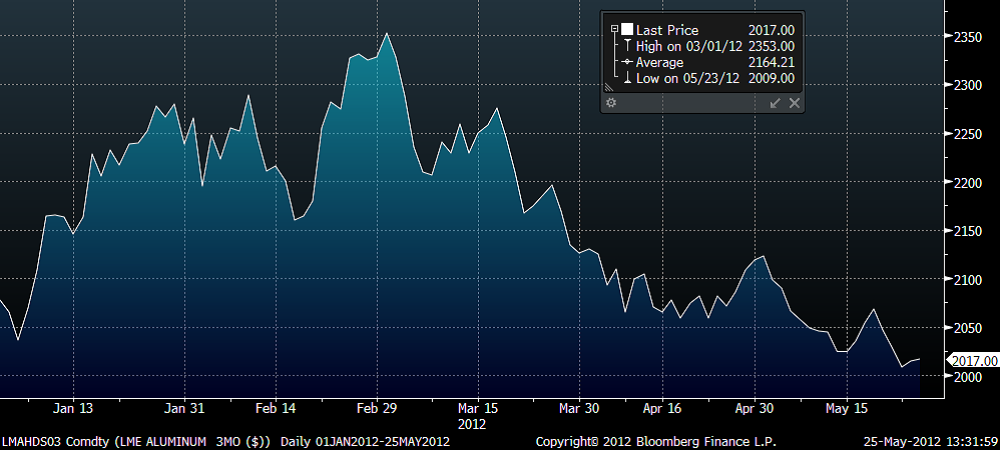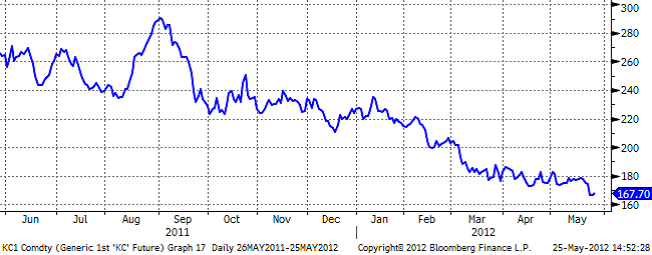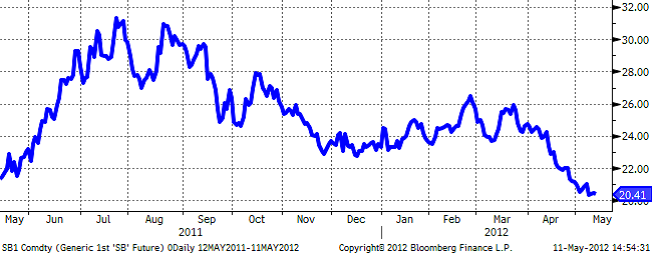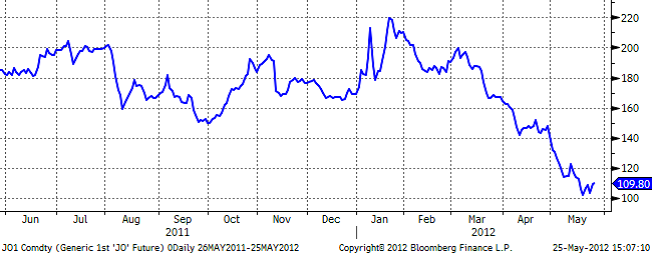Analys
SHB Råvarubrevet 25 maj 2012
 Marknaden har fortsatt att präglas av svalare riskaptit sedan förra veckobrevet. Råvaror tillsammans med börser och räntor har fallit. Oron för en grekisk närtida exit får sägas ha ökat, ratingnedgraderingarna har stått som spön i backen, spanska problemlån klättrar snabbt medan makrostatistiken inte gett några skäl till optimism. Kinadata har fortsatt att vara besvikelser med banken HSBCs preliminära inköpschefsindex för maj som senaste exempel. Vi tror på en kommande stark återhämtning för kinaexponerade råvaror – men inte ännu!
Marknaden har fortsatt att präglas av svalare riskaptit sedan förra veckobrevet. Råvaror tillsammans med börser och räntor har fallit. Oron för en grekisk närtida exit får sägas ha ökat, ratingnedgraderingarna har stått som spön i backen, spanska problemlån klättrar snabbt medan makrostatistiken inte gett några skäl till optimism. Kinadata har fortsatt att vara besvikelser med banken HSBCs preliminära inköpschefsindex för maj som senaste exempel. Vi tror på en kommande stark återhämtning för kinaexponerade råvaror – men inte ännu!
Parallellt med de negativa rubrikerna så har förväntansbilden skruvats ned kraftigt och det minskar risken för att makrodata blir besvikelser i närtid. När tillgångar har falligt med 10 – 15 % (OMX 30 och Brent) på mindre än två månader så brukar det komma en kort rekyl när köpintresset ökar igen.
Vi konstaterar att mycket dålig data kommit på kort tid och tryckt ner marknaden. Vi ser fortfarande flera nedåtrisker på 2 månaders sikt men tycker att detta kan vara ett intressant läge för den riskvillige att kortsiktigt söka avkastning i en annars dyster miljö. Vi favoriserar då mindre kinaexponerade råvaror som olja, som vi dessutom tycker har starkast fundamentalt stöd utav råvarorna.
Energi (neutral)
Olja
Oljemarknaden (Brent) som backade med ytterligare 3 procent ned till 105 dollar under inledningen av veckan återhämtar delar av rörelsen mot slutet vilket får ses som en korrektion. Fokus på Europa och lägre riskaptit för råvaror överlag men ser vi till det fundamentala lär även förbrukningsprognoser för den amerikanska marknaden skrivas ned något ytterligare inom den närmaste framtiden. En del stöd från amerikanska bensinlager som fortsatte ned och totalt nu fallit med 30 miljoner fat de senaste tre månaderna. Inga stora nyheter kring Iran där diskussionerna kring kärnvapenprogrammet flyttas fram till nästa månad. En nyhet om 300,000 fat mindre Iransk olja till marknaden med ett potentiellt scenario om 1 miljoner bortfall skulle tidigare givit ett ordentligt stöd åt köparna men i denna pessimistiska miljö påverkar det knappt alls. Trots en tekniskt väldigt översåld marknad verkar det fortsatt som risken finns på nedsidan på kort sikt.
Elmarknaden
Den försvagade energibalansen som bidrog till förra veckans uppgång genererade även inledningsvis av denna vecka en del köpintressen i marknaden. Överskottet om närmare 12 TWh har krympt till 6TWh på lite drygt en månad. Kvartalet Q3 2012 som är underliggande för SHB Power Index och våra sparprodukter handlas dock oförändrat efter att sentimentet försvagades något i mitten av veckan till följd av den allmänna utvecklingen på börserna. Mot slutet av veckan pekar prognoserna fortsatt på ett något torrare scenario där vi förväntas få mellan 2-4 TWh vilket därmed är något under normalen om 4.2 TWh för perioden. Denna högtrycksuppbyggnad och torra period har balanserats något av den svaga kolmarknaden där ett stort överskott och en stark dollar verkat negativt för kol och dämpa utvecklingen på el. En viss rekyl på både kol (där brytpriset för kolkraft stigit med ca 1 euro) och utsläppsrätter mot slutet av veckan men vi bedömer detta som tillfälligt och förväntar oss ingen vidare uppgång, snarare tvärtom.
Ser vi till den korta kurvan så är spotpriserna riktigt låga och väntas så vara även under nästa vecka. De höga temperaturerna gör att vattenproducenter har svårt att upprätthålla spotpriset på någon högre nivå till följd av den kraftiga snösmältningen. För att sammanfatta läget talar flera faktorer för att vi kommer att ligga kvar på dessa låga nivåer och om inte prognoserna slår om till betydligt torrare än de vi ser idag bör Q3 2012 kunna falla tillbaka någon euro under inledningen av nästa vecka.
Basmetaller (neutral)
Kopparpriset har pendlat upp och ner i pris under veckan för att stänga på ungefär oförändrat. Sedan årets början är priset ned ca 1.7 %. Koppar har den senaste tiden tagit stryk på grund av oron kring Grekland och världsekonomin. Som bekant anses metallen vara en ledande indikator för världskonjunkturen.
Kopparlagren från LME ökade för första gången på 7 veckor. Nyligen släppta produktionssiffror visar på att brytningen av koppar kommer överstiga efterfrågan redan i år och även 2014. I den andra vågskålen hittar vi siffror från världens största kopparproducent, chilenska Codelco. Företaget har producerat 10 % mindre koppar första kvartalet jämfört med första kvartalet 2011. Den främsta anledningen sägs vara minskade kopparhalter i malmen. Sammantaget är vi neutrala till kopparpriset.
Aluminiumpriset har under veckan gått ned med 2.4 %. Nedgången hittills i år är 2.8 %. Priset ligger i skrivande stund på 2 018 USD/ton. Ett flertal kunder har visst intresse att köpa strax över 2 000 USD-nivån. Cash-cost, det vill säga kostnaden för att få fram ett ton, ligger runt 1 900 enligt flera bedömare. Att kunna säkra in sin exponering på något över 2 000 har lockat in köparna.
Om vi försöker hitta positiva signaler kring världsekonomin så hittar vi det faktiskt i aluminiummarknaden. Leveranser till japanska förbrukare är upp för den tredje månaden i rad. Vi även snappat upp att importen av bauxit (råvaran till aluminium) till Kina har gått 49 % jämfört med förra året. Vi är neutrala till metaller och aluminium prismässigt, men tror att aluminium har bäst potential för prisuppgång på sikt.
Ädelmetaller
I slutet av förra veckan studsade guldet upp ganska ordentligt från nya årslägsta-nivåer, men denna veckan har vi sett det glida tillbaks med 2 %. Även övriga ädelmetaller har fallit i samma storleksordning, under en lugn vecka. Vi håller fast vår negativa syn på sektorn baserat på avsaknad av performance i den riskaverta miljö vi haft under senare tid.
Softs
Kaffe
Marknaden inväntar de brasilianska arabica skördarna vilka fortskrider något långsammare i år än tidigare år p.g.a. regn. Skördarna förväntas bli goda till följd av gynnsamma väderförhållanden under gångna säsongen men det råder fortsättningsvis en ovisshet beträffande landets kommande exportvolym då man ser en ökad inhemsk konsumtion. Efterfrågan på arabica kaffet har varit låg då flertalet köpare haft välfyllda lager inför skörden 2012/13.
Priset på arabica bönan har sjunkit drygt 20 % under 2012 inväntandes 2011/12 skörden vi nu står inför, kaffekonsumtionen förväntas öka globalt de kommande åren och skörden 2013-14 benämns som ett ”off” år i arabicakaffets skördecykler (högre/lägre skörd vartannat år).
Socker
Socker handlades upp något i början av veckan till följd av det något torrare vädret i Brasilien och därmed risk för sämre skördar. Även en något ökad efterfrågan och rapporter om ökat antal lastfartyg vid de brasilianska hamnarna redo för lastning av råvaran fick priset att stiga. Det ekonomiska läget i Europa fick priset på socker att sjunka igen mot mitten av veckan och handlas fortsättningsvis lågt. Marknaden är något avvaktande inför brasilianska skördeperioden som inleds om bara några veckor, och inväntar även handeln inför ramadan som hittills varit modest. Ramadan inleds i juli och de muslimska länderna brukar fylla sina lager innan dess. Indien som förra veckan beslöt att tillåta obegränsad export av socker har inte publicerat sin planerade exportvolym. Indiens skördar är goda i år och det socker de inte exporterar i år har de möjlighet att lagra för export nästa år, vilket i sin tur kan påverka priset på sikt.
Apelsinjuice
Priset på apelsinjuice fortsätter på sin låga nivå till följd av ökat utbud och den rådande ekonomiska situationen i Europa håller efterfrågan på fortsatt låga nivåer. Väderförhållandena har varit gynnsamma och skördarna är goda. Florida närmar sig orkansäsongen och antalet namngivna orkaner motsvarar tidigare år även om man i år inväntar orkaner något tidigare på säsongen. Även om säsongens tidiga orkaner i sig inte verkar utgöra något större hot för skörden påminner de marknaden om risken och tillfälliga uppgångar i priset har setts. Brasiliens Real har tappat 5,5 % mot USD sedan jan 2012.
Handelsbankens Råvaruindex
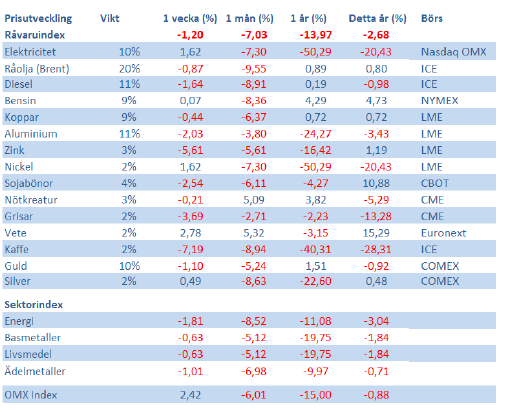 Handelsbankens råvaruindex består av de underliggande indexen för respektive råvara. Vikterna är bestämda till hälften från värdet av global produktion och till hälften från likviditeten i terminskontrakten.
Handelsbankens råvaruindex består av de underliggande indexen för respektive råvara. Vikterna är bestämda till hälften från värdet av global produktion och till hälften från likviditeten i terminskontrakten.
[box]SHB Råvarubrevet är producerat av Handelsbanken och publiceras i samarbete och med tillstånd på Råvarumarknaden.se[/box]
Ansvarsbegränsning
Detta material är producerat av Svenska Handelsbanken AB (publ) i fortsättningen kallad Handelsbanken. De som arbetar med innehållet är inte analytiker och materialet är inte oberoende investeringsanalys. Innehållet är uteslutande avsett för kunder i Sverige. Syftet är att ge en allmän information till Handelsbankens kunder och utgör inte ett personligt investeringsråd eller en personlig rekommendation. Informationen ska inte ensamt utgöra underlag för investeringsbeslut. Kunder bör inhämta råd från sina rådgivare och basera sina investeringsbeslut utifrån egen erfarenhet.
Informationen i materialet kan ändras och också avvika från de åsikter som uttrycks i oberoende investeringsanalyser från Handelsbanken. Informationen grundar sig på allmänt tillgänglig information och är hämtad från källor som bedöms som tillförlitliga, men riktigheten kan inte garanteras och informationen kan vara ofullständig eller nedkortad. Ingen del av förslaget får reproduceras eller distribueras till någon annan person utan att Handelsbanken dessförinnan lämnat sitt skriftliga medgivande. Handelsbanken ansvarar inte för att materialet används på ett sätt som strider mot förbudet mot vidarebefordran eller offentliggörs i strid med bankens regler.
Analys
Brent crude set to dip its feet into the high $50ies/b this week

Parts of the Brent crude curve dipping into the high $50ies/b. Brent crude fell 2.3% over the week to Friday. It closed the week at $61.29/b, a slight gain on the day, but also traded to a low of $60.14/b that same day and just barely avoided trading into the $50ies/b. This morning it is risk-on in equities which seems to help industrial metals a little higher. But no such luck for oil. It is down 0.8% at $60.8/b. This week looks set for Brent crude to dip its feet in the $50ies/b. The Brent 3mth contract actually traded into the high $50ies/b on Friday.

The front-end backwardation has been on a weakening foot and is now about to fully disappear. The lowest point of the crude oil curve has also moved steadily lower and lower and its discount to the 5yr contract is now $6.8/b. A solid contango. The Brent 3mth contract did actually dip into the $50ies/b intraday on Friday when it traded to a low point of $59.93/b.
More weakness to come as lots of oil at sea comes to ports. Mid-East OPEC countries have boosted exports along with lower post summer consumption and higher production. The result is highly visibly in oil at sea which increased by 17 mb to 1,311 mb over the week to Sunday. Up 185 mb since mid-August. On its way to discharge at a port somewhere over the coming month or two.
Don’t forget that the oil market path ahead is all down to OPEC+. Remember that what is playing out in the oil market now is all by design by OPEC+. The group has decided that the unwind of the voluntary cuts is what it wants to do. In a combination of meeting demand from consumers as well as taking back market share. But we need to remember that how this plays out going forward is all at the mercy of what OPEC+ decides to do. It will halt the unwinding at some point. It will revert to cuts instead of unwind at some point.
A few months with Brent at $55/b and 40-50 US shale oil rigs kicked out may be what is needed. We think OPEC+ needs to see the exit of another 40-50 drilling rigs in the US shale oil patches to set US shale oil production on a path to of a 1 mb/d year on year decline Dec-25 to Dec-26. We are not there yet. But a 2-3 months period with Brent crude averaging $55/b would probably do it.
Oil on water increased 17 mb over the week to Sunday while oil in transit increased by 23 mb. So less oil was standing still. More was moving.

Crude oil floating storage (stationary more than 7 days). Down 11 mb over week to Sunday

The lowest point of the Brent crude oil curve versus the 5yr contract. Weakest so far this year.

Crude oil 1mth to 3mth time-spreads. Dubai held out strongly through summer, but then that center of strength fell apart in late September and has been leading weakness in crude curves lower since then.

Analys
Crude oil soon coming to a port near you

Rebounding along with most markets. But concerns over solidity of Gaza peace may also contribute. Brent crude fell 0.8% yesterday to $61.91/b and its lowest close since May this year. This morning it is bouncing up 0.9% to $62.5/b along with a softer USD amid positive sentiment with both equities and industrial metals moving higher. Concerns that the peace in Gaza may be less solid than what one might hope for also yields some support to Brent. Bets on tech stocks are rebounding, defying fears of trade war. Money moving back into markets. Gold continues upwards its strong trend and a softer dollar helps it higher today as well.

US crude & products probably rose 5.6 mb last week (API) versus a normal seasonal decline of 2.4 mb. The US API last night partial and thus indicative data for US oil inventories. Their data indicates that US crude stocks rose 7.4 mb last week, gasoline stocks rose 3.0 mb while Distillate stocks fell 4.8 mb. Altogether an increase in commercial crude and product stocks of 5.6 mb. Commercial US crude and product stocks normally decline by 2.4 mb this time of year. So seasonally adjusted the US inventories rose 8 mb last week according to the indicative numbers by the API. That is a lot. Also, the counter seasonal trend of rising stocks versus normally declining stocks this time of year looks on a solid pace of continuation. If the API is correct then total US crude and product stocks would stand 41 mb higher than one year ago and 6 mb higher than the 2015-19 average. And if we combine this with our knowledge of a sharp increase in production and exports by OPEC(+) and a large increase in oil at sea, then the current trend in US oil inventories looks set to continue. So higher stocks and lower crude oil prices until OPEC(+) switch to cuts. Actual US oil inventory data today at 18:00 CET.
US commercial crude and product stocks rising to 1293 mb in week 41 if last nights indicative numbers from API are correct.

Crude oil soon coming to a port near you. OPEC has lifted production sharply higher this autumn. At the same time demand for oil in the Middle-East has fallen as we have moved out of summer heat and crude oil burn for power for air-conditioning. The Middle-East oil producers have thus been able to lift exports higher on both accounts. Crude oil and condensates on water has shot up by 177 mb since mid-August. This oil is now on its way to ports around the world. And when they arrive, it will likely help to lift stocks onshore higher. That is probably when we will lose the last bit of front-end backwardation the the crude oil curves. That will help to drive the front-month Brent crude oil price down to the $60/b line and revisit the high $50ies/b. Then the eyes will be all back on OPEC+ when they meet in early November and then again in early December.
Crude oil and condensates at sea have moved straight up by 177 mb since mid-August as OPEC(+) has produced more, consumed less and exported more.

Analys
The Mid-East anchor dragging crude oil lower

When it starts to move lower it moves rather quickly. Gaza, China, IEA. Brent crude is down 2.1% today to $62/b after having traded as high as $66.58/b last Thursday and above $70/b in late September. The sell-off follows the truce/peace in Gaze, a flareup in US-China trade and yet another bearish oil outlook from the IEA.

A lasting peace in Gaze could drive crude oil at sea to onshore stocks. A lasting peace in Gaza would probably calm down the Houthis and thus allow more normal shipments of crude oil to sail through the Suez Canal, the Red Sea and out through the Bab-el-Mandeb Strait. Crude oil at sea has risen from 48 mb in April to now 91 mb versus a pre-Covid normal of about 50-60 mb. The rise to 91 mb is probably the result of crude sailing around Africa to be shot to pieces by the Houthis. If sailings were to normalize through the Suez Canal, then it could free up some 40 mb in transit at sea moving onshore into stocks.
The US-China trade conflict is of course bearish for demand if it continues.
Bearish IEA yet again. Getting closer to 2026. Credibility rises. We expect OPEC to cut end of 2025. The bearish monthly report from the IEA is what it is, but the closer we get to 2026, the more likely the IEA is of being ball-park right in its outlook. In its monthly report today the IEA estimates that the need for crude oil from OPEC in 2026 will be 25.4 mb/d versus production by the group in September of 29.1 mb/d. The group thus needs to do some serious cutting at the end of 2025 if it wants to keep the market balanced and avoid inventories from skyrocketing. Given that IEA is correct that is. We do however expect OPEC to implement cuts to avoid a large increase in inventories in Q1-26. The group will probably revert to cuts either at its early December meeting when they discuss production for January or in early January when they discuss production for February. The oil price will likely head yet lower until the group reverts to cuts.
Dubai: The Mid-East anchor dragging crude oil lower. Surplus emerging in Mid-East pricing. Crude oil prices held surprisingly strong all through the summer. A sign and a key source of that strength came from the strength in the front-end backwardation of the Dubai crude oil curve. It held out strong from mid-June and all until late September with an average 1-3mth time-spread premium of $1.8/b from mid-June to end of September. The 1-3mth time-spreads for Brent and WTI however were in steady deterioration from late June while their flat prices probably were held up by the strength coming from the Persian Gulf. Then in late September the strength in the Dubai curve suddenly collapsed. Since the start of October it has been weaker than both the Brent and the WTI curves. The Dubai 1-3mth time-spread now only stands at $0.25/b. The Middle East is now exporting more as it is producing more and also consuming less following elevated summer crude burn for power (Aircon) etc.
The only bear-element missing is a sudden and solid rise in OECD stocks. The only thing that is missing for the bear-case everyone have been waiting for is a solid, visible rise in OECD stocks in general and US oil stocks specifically. So watch out for US API indications tomorrow and official US oil inventories on Thursday.
No sign of any kind of fire-sale of oil from Saudi Arabia yet. To what we can see, Saudi Arabia is not at all struggling to sell its oil. It only lowered its Official Selling Prices (OSPs) to Asia marginally for November. A surplus market + Saudi determination to sell its oil to the market would normally lead to a sharp lowering of Saudi OSPs to Asia. Not yet at least and not for November.
The 5yr contract close to fixed at $68/b. Of importance with respect to how far down oil can/will go. When the oil market moves into a surplus then the spot price starts to trade in a large discount to the 5yr contract. Typically $10-15/b below the 5yr contract on average in bear-years (2009, 2015, 2016, 2020). But the 5yr contract is usually pulled lower as well thus making this approach a moving target. But the 5yr contract price has now been rock solidly been pegged to $68/b since 2022. And in the 2022 bull-year (Brent spot average $99/b), the 5yr contract only went to $72/b on average. If we assume that the same goes for the downside and that 2026 is a bear-year then the 5yr goes to $64/b while the spot is trading at a $10-15/b discount to that. That would imply an average spot price next year of $49-54/b. But that is if OPEC doesn’t revert to cuts and instead keeps production flowing. We think OPEC(+) will trim/cut production as needed into 2026 to prevent a huge build-up in global oil stocks and a crash in prices. But for now we are still heading lower. Into the $50ies/b.
-

 Nyheter4 veckor sedan
Nyheter4 veckor sedanOPEC+ missar produktionsmål, stöder oljepriserna
-

 Nyheter2 veckor sedan
Nyheter2 veckor sedanGoldman Sachs höjer prognosen för guld, tror priset når 4900 USD
-

 Nyheter4 veckor sedan
Nyheter4 veckor sedanEtt samtal om guld, olja, fjärrvärme och förnybar energi
-

 Nyheter3 veckor sedan
Nyheter3 veckor sedanBlykalla och amerikanska Oklo inleder ett samarbete
-

 Nyheter3 veckor sedan
Nyheter3 veckor sedanGuld nära 4000 USD och silver 50 USD, därför kan de fortsätta stiga
-

 Analys4 veckor sedan
Analys4 veckor sedanAre Ukraine’s attacks on Russian energy infrastructure working?
-

 Nyheter4 veckor sedan
Nyheter4 veckor sedanGuldpriset uppe på nya höjder, nu 3750 USD
-

 Nyheter3 veckor sedan
Nyheter3 veckor sedanEtt samtal om guld, olja, koppar och stål


